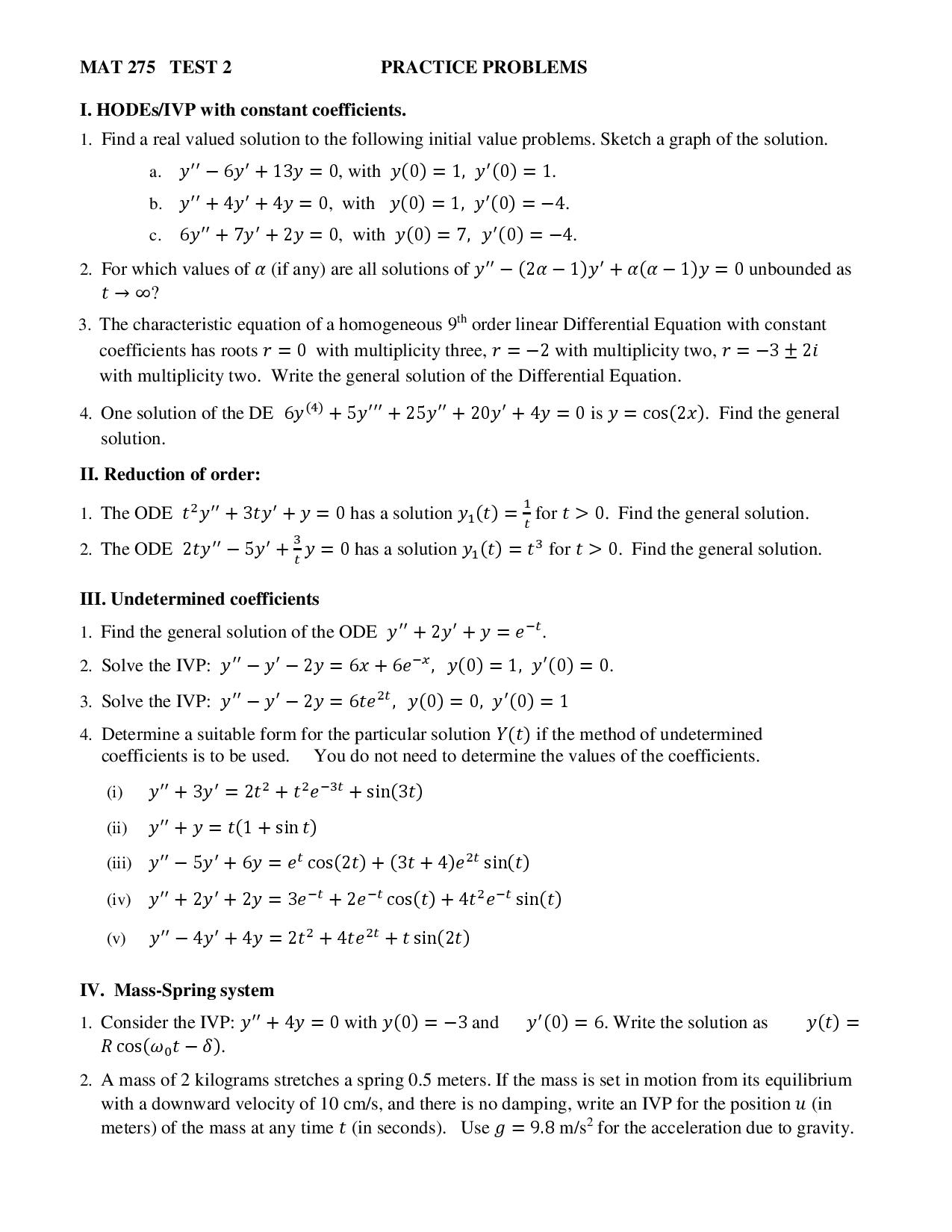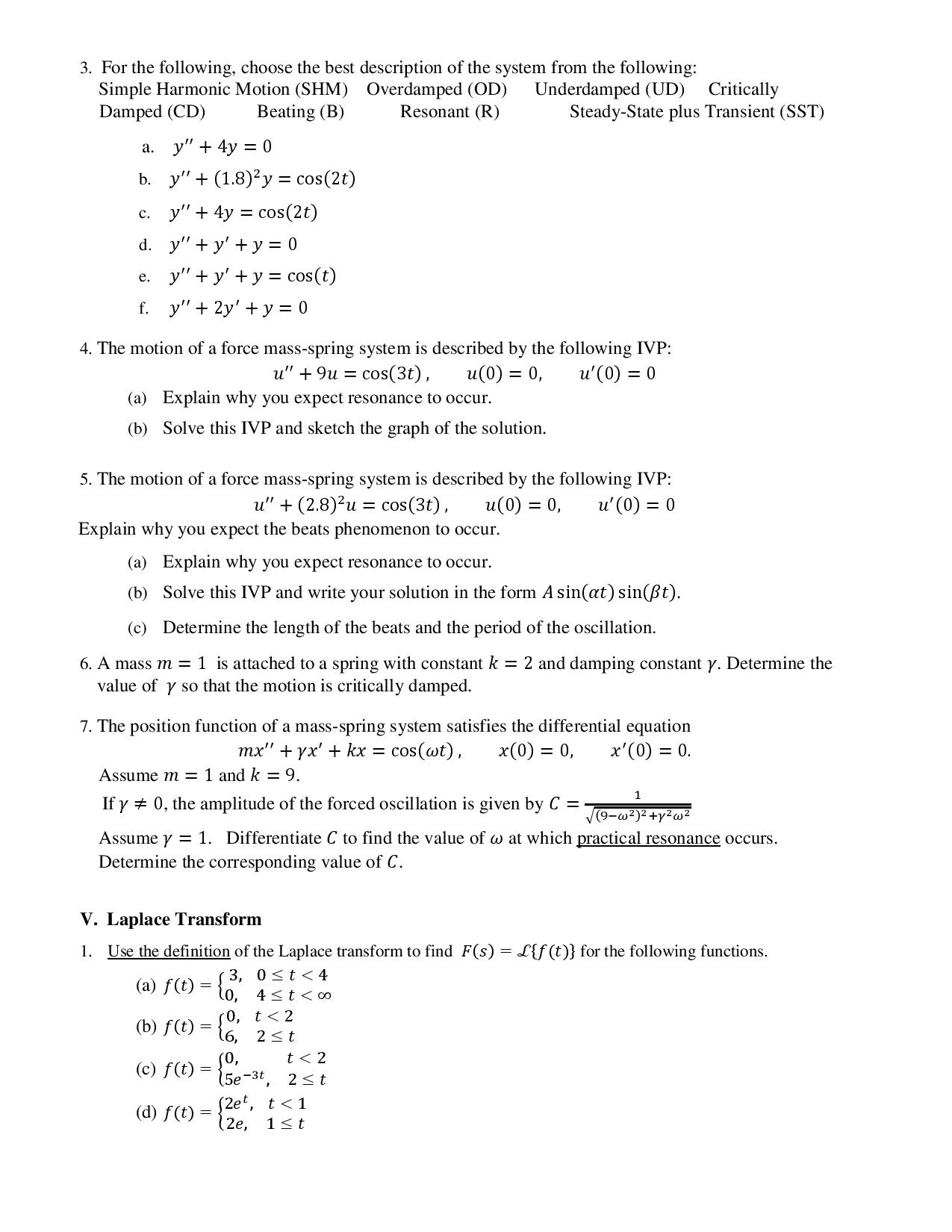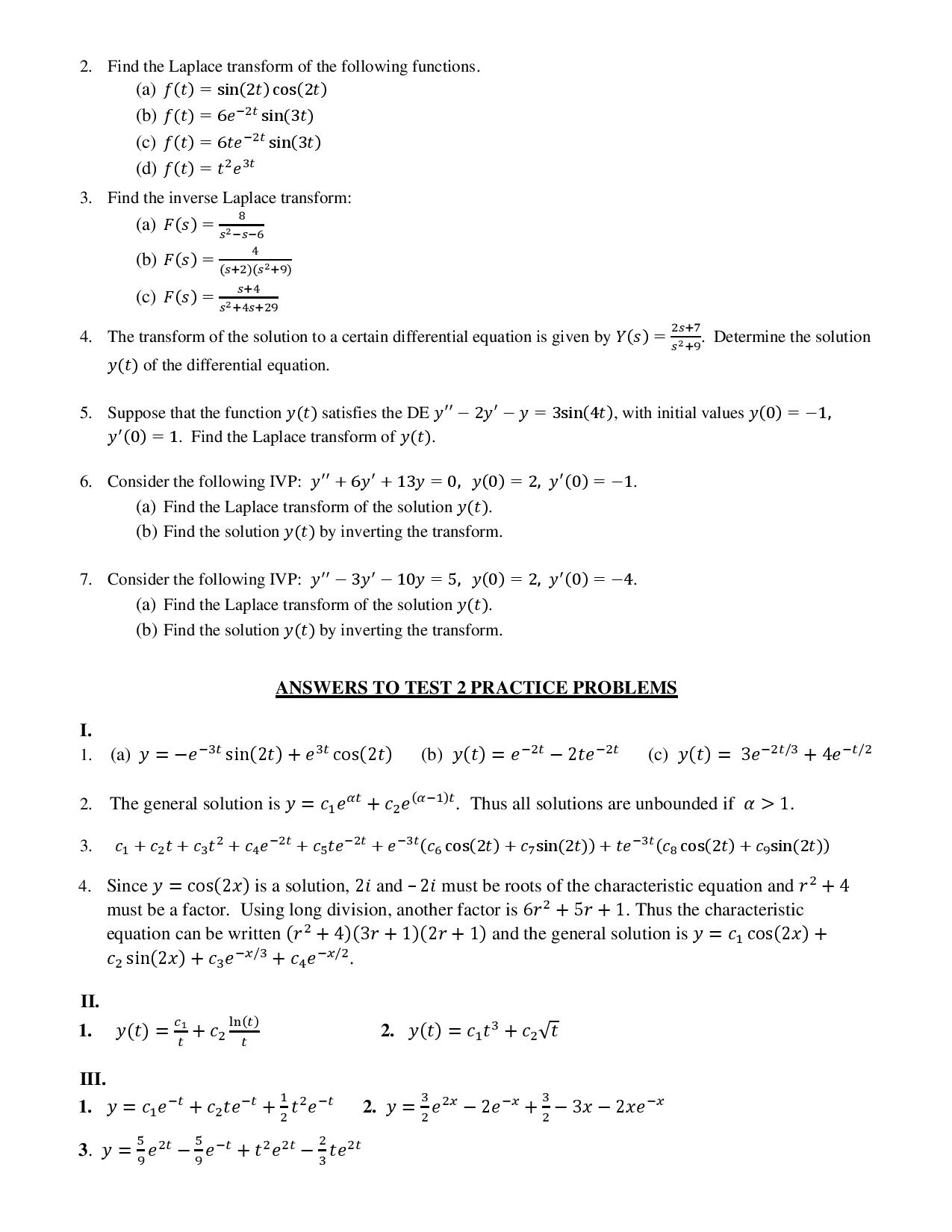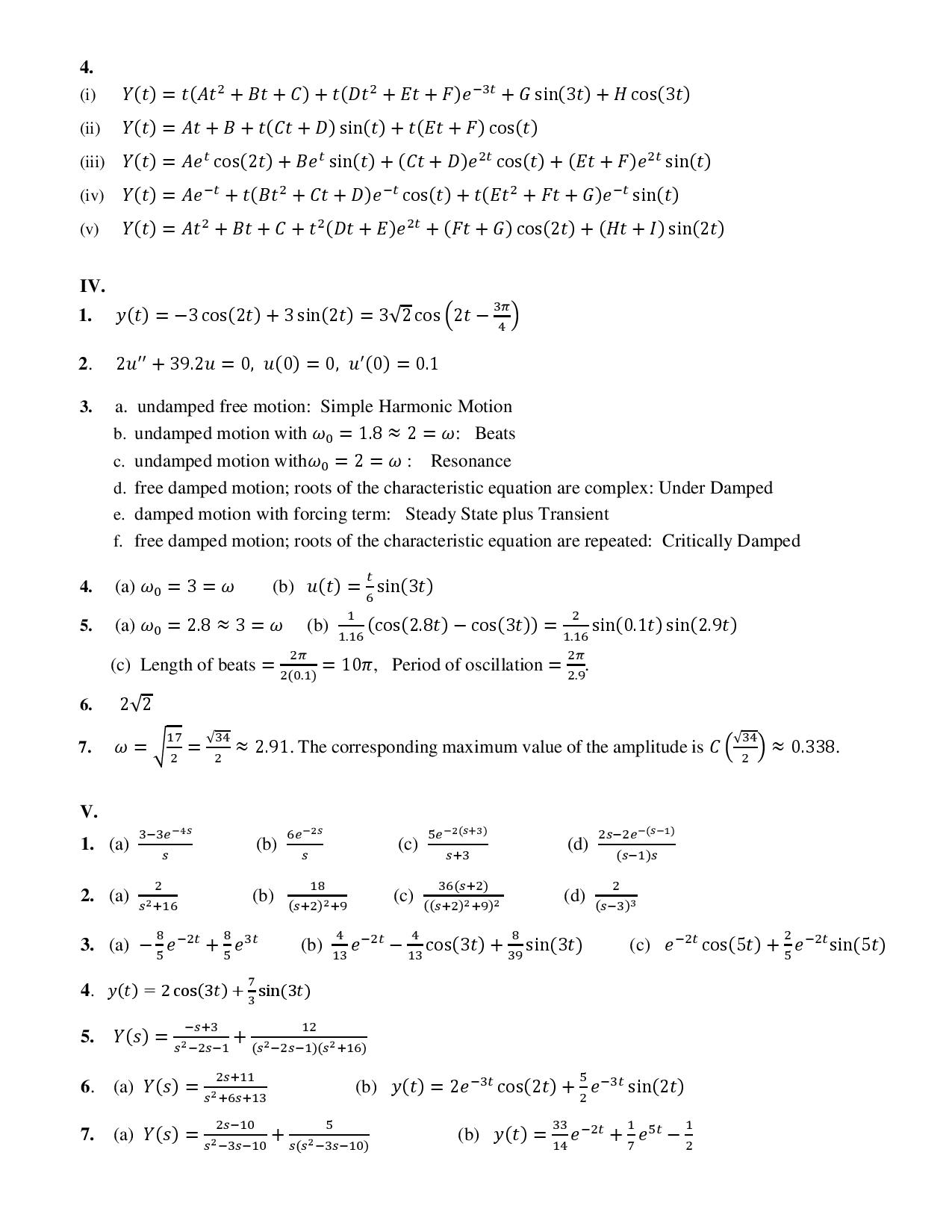Can you provide solutions for the attached pdf? The answers are included, but I would like some assistance on the steps to get the answer.
Thanks!
MAT 275 TEST 2 PRACTICE PROBLEMS I. HODEs/IVP with constant coefficients. 1. Find a real valued solution to the following initial value problems. Sketch a graph of the solution. a. y\" 6}" + 1331 = 0, with y(0) = 1, 3"(0) = 1- b. y\" + 4y' + 4y = 0. with you = 1. Ho) = -4- c. 6y" + 7}" + 2y = 0. with 31(0) = 7 3'10): '4- 2. For which values of or (if any) are all solutions of y\" (2a 1)y' + (101 1)); = 0 unbounded as t > 00? 3. The characteristic equation of a homogeneous 91\" order linear Differential Equation with constant coefficients has roots 7' = 0 with multiplicity three, 1' = 2 with multiplicity two, r = 3 i 21' with multiplicity two. Write the general solution of the Differential Equation. 4. One solution of the DE 6y\") + Sy'" + 253.!" + 20y' + 4y = 0 is y = cos (2x). Find the general solution. IL Reduction of order: 1. The ODE tzy" + 3ty' + y = 0 has a solution 350?) = %for t > 0. Find the general solution. 2. The ODE Zty\" Sy' + $31 = 0 has a solution 3110') = t3 for t > 0. Find the general solution. III. Undetermined coefficients 1. Find the general solution of the ODE y" + Zy' + y = (ft. 2. Solve the IVP: y" y' 2y = 6x + 6e\3. For the following, choose the best description of the system from the following: Simple Harmonic Motion (SHM) Overdamped (OD) Underdamped (UD) Critically Damped (CD) Beating (B) Resonant (R) Steady-State plus Transient (S ST) 3. y\" + 43/ = 0 b. y\" + (1.8)2y = cos(2t) c. y\" + 4)! = cos(2t) d. y\" + y' + y = 0 e. y\" + y' + y = c0505) f. y\"+2y'+y=0 4. The motion of a force mass-spring system is described by the following IVP: u\" + 9n = cos(3t), u(0) = 0, u'(0) = 0 (a) Explain why you expect resonance to occur. (b) Solve this WP and sketch the graph of the solution. 5. The motion of a force mass-spring system is described by the following IVP: u" + (2.8)211 = cos(3t), 11(0) 2 0, u'(0) = 0 Explain why you expect the beats phenomenon to occur. (3) Explain why you expect resonance to occur. (b) Solve this IVP and write your solution in the form A sin(at) sintt). (c) Determine the length of the beats and the period of the oscillation. 6. A mass m = 1 is attached to a sprin g with constant k = 2 and damping constant 1/. Determine the value of 1: so that the motion is critically damped. 7. The position function of a mass-spring system satisfies the differential equation mx\" + yx' + kx : cos(mt), 13(0) : 0, x'(0) : 0. Assumem = 1 and k = 9. [fy at 0, the amplitude of the forced oscillation is given by C = J; (9m2)2 +1,sz Assume y = 1. Differentiate C to find the value of a; at which practical resonance occurs. Determine the corresponding value of C. V. Laplace Transform 1. Use the denition of the Laplace transform to find 17(5) = .I {f (15)] for the following functions. (a)f
1. c1 + czt + (331'2 + cute2t + c5te'2t + e'3t(c5 (105(2t) + cysin(2t)) + te _3t(C3 cos(2t) + cgsin(2t)) Since 3/ = cos(2x) is a solution, 2: and 21' must be roots of the characteristic equation and r2 + 4 must be a factor. Using long division, another factor is 6r2 + 5?" + 1. Thus the characteristic equation can be written 0'2 + 4X31\" + 1)(2r + 1) and the general solution is y = 61 cos(2x) + c2 sin(2x) + age\"73 + Lure\"2. 2. y(t) = cit3 + sz/E 3 y = 618: + Cztet {Elizat 2. y = 2.92" 23\" +3 31: 2xe_x 5 5 2 __ 2r. _ t. 2 2t _ 2t 3.yge 9e +te 3te (i) Y(t) = t(At2 + Br + C) + t(Dr2 + Er + F).23't + G sin(3t) + H cos(3t) (ii) Y(r) = Ar + B + t(Cr + D) sin(t) + :09: + F) cos(t) (iii) Y(t) = Aet cos(2t) + Bet sin(t) + (Ct + D)e2t cos(t) + (Er + F)?\" sin(t) (iv) Y(t) = Ae" + t(Bt2 + Ct + D)e" cos(t) + t(Et2 + Ft + (Det sin(r) (v) 1'03) 2 Ar2 + Br + C + r2(Dr + E).e2t + (Ft + G) cos(2r) + (Hr + I) sin(2r) IV. 1. y(t) = 3 cos(2t) + 3 sin(2t) 2 315cm (2t 3%!) 2. 2n" + 39.211 = 0, 21(0) = 0, u'(0) = 0.1 3. a. undamped free motion: Simple Harmonic Motion D" . undamped motion with too = 1.8 a: 2 = a): Beats undamped motion withm0 = 2 = m : Resonance C. (1. free damped motion; roots of the characteristic equation are complex: Under Damped e. damped motion with forcing term: Steady State plus Transient f. free damped motion; roots of the characteristic equation are repeated: Critically Damped 4. (a) mo 2 3 = w (b) 110') = sin(3t) 5. (a) mo = 2.8 a: 3 = a; (b) 1130205030 cos(3t)) = sinmar) sin(2.9t) 21: . . . _ 2\" 2(01) 10\










